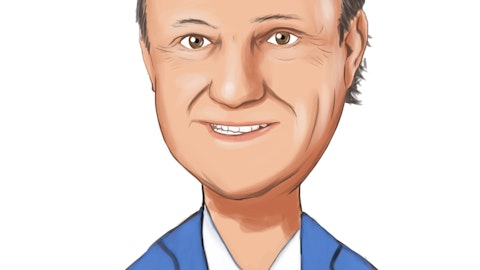Ki Bin Kim: Thank you, good morning. Just going back to the topic of the lease renewals and that process, how would you describe the kind of key hurdle? Is it the fact that you’re dealing with a kind of large, much larger bureaucratic entity or is it really just trying to negotiate the right rental rate? Just curious if any kind of color you can provide?
Andrew Spodek: Sure. This is Andrew. So I think in general it’s complicated to negotiate 100 to 200 leases at one given time, right, depending on how many we have rolling in that particular year. Dealing with a government agency adds a layer of complication to it analyzing each individual properties market and what the rates are and negotiating that adds another layer to it. So I think it’s just the process of going through it. I don’t think there’s a particular hurdle that’s specific to it.
Ki Bin Kim: Okay. And in terms of G&A, any kind of ballpark idea of what we can expect going forward? I think last year, I mean this year compared to last year G&A went up about $2 million. Is that something that’s reasonable to expect next year?
Robert Klein: So we haven’t given guidance for next year. We plan to do that in the next quarter. But no we don’t believe that some of the one-time increases will be recurring in the coming year. So the increase shouldn’t be large, but we will give you guidance in the next quarter as to how 2024 is going to look.
Ki Bin Kim: Okay, thank you.
Operator: Thank you. [Operator Instructions] Our next question comes from the line of Ki Bin Kim with Truist Securities. Please proceed with your question.
Ki Bin Kim: Yes, that was a quick turnaround. Just a quick question on the acquisition yields. I didn’t want to hog up the call, you know. I guess where would you peg seller expectations to this kind of new cost of capital environment? Have they kind of fully embraced it and realized what’s happening to such as to buyers like yourselves in terms of your increased cost of capital and what do you think cap raise can kind of drift to as we look forward?
Robert Klein: It’s a great question and I wish I had a great answer. We do a tremendous amount of volume and so every seller’s expectation is very different and actually every seller’s asset is very different, right. And so this particular quarter, our team did very well closing out the quarter around an 8 cap. But that was really because of the mix of assets that we bought within the quarter. From the first half of last year where we closed out at 6.5 cap to where we are today, but let’s call it a 7.5 to 8 cap, that’s a big move. But this is not a market shift. We’re still having to negotiate to get these cap rates on an individual deal basis. We’re hoping that next quarter is going to be a 7.5 or higher. I don’t want anybody to expect this 8 cap quarter to be a change in the market itself.
But we’re working on getting the best pricing that we possibly can and we’re taking into account our cost of capital as we do those deals. Can I tell you that the sellers recognize the cost of capital shift, if they are recognizing that they are not voicing it to us. They are still saying that they want their price, which I guess is part of the game.
Ki Bin Kim: Okay. Thank you.
Robert Klein: Thank you.
Operator: Thank you. Our next question comes from the line of Jon Petersen with Jefferies. Please proceed with your question.
Jonathan Petersen: Great. Thanks. Good morning, guys. I was just curious if there’s any, I don’t know, maybe updated trends on where you’re seeing the Post Office make investments today, especially as it relates to your business. I know in the past we talked about them upgrading their fleet of trucks or I don’t know if there’s different store designs or things like that that we should be aware of. Just curious if there’s any, any trends in that regard that are impacting your business that we should be aware of?
Andrew Spodek: So I believe that there are trends, but I don’t know that it’s directly impacting our business. They have been investing heavily in their own facilities and the modernization of those facilities, which is a good thing for the operations of their business. I don’t know that it’s directly impacting our properties though.
Jonathan Petersen: Okay, all right, that’s fine. All right, thank you. That’s all I got.
Andrew Spodek: Thank you.
Operator: Thank you. Our next question comes from the line of Tony Paolone with JPMorgan. Please proceed with your question.
Anthony Paolone: Good morning, guys. You have Nahom on the line for Tony this morning. Congrats on executing the 2022 leases with the USPS with the 3.5% escalators. I guess going forward are you negotiating similar types of leases with the USPS and is that maybe causing some of the hold up in renewals?
Jeremy Garber: You know as Andrew referenced, this is a process. The number of leases that we’re going through on an annual basis is voluminous and facing off with the Postal Service and the back and forth just takes some time and we’ve been at this for many, many years. This has been the experience over the history and right now we’re more focused on developing with them a more efficient process. So we don’t have to go through this year in year out. Our goal is to achieve the best outcome for our shareholders on any type of lease renewal and so that’s where we are today, and again our goal is to try to bring this to a head as soon as we can.
Anthony Paolone: Got it. Thank you. That’s it from me.
Operator: Thank you. We have reached the end of our question-and-answer session and I would like to turn the floor back over to CEO, Andrew Spodek for closing comments.
Andrew Spodek: Thanks. On behalf of the entire team, thank you for your continued support and taking the time to join us today. We look forward to connecting with you over the next coming months. Thank you again.
Operator: Thank you. This concludes today’s teleconference. You may now disconnect your lines at this time. Thank you for your participation.
Follow Postal Realty Trust Inc. (NYSE:PSTL)
Follow Postal Realty Trust Inc. (NYSE:PSTL)
Receive real-time insider trading and news alerts



